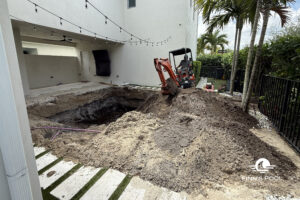Thinking about giving your swimming pool a facelift? Over time, even the best-built pools show their age with chips, cracks, and fading colors.
If your pool is starting to look a bit tired despite regular upkeep, it might be time to consider getting a pool builder for replastering or resurfacing.
Plastering on a swimming pool can pit and make it look old and drab. You can change the pool’s appearance by scheduling pool replastering in West Palm Beach.
This guide will walk you through the why and how of giving your pool a fresh, new plaster coat that can extend its life and enhance its appearance.
Why Does A Pool Lose Its Original Bright Appearance?
Over time, every swimming pool begins to lose its once-vibrant finish. Here are some reasons why this happens:
1 Chemical Wear: Regular exposure to pool chemicals gradually erodes the shiny finish.
2. Water Chemistry: If not balanced properly, water chemistry can accelerate the degradation of plaster.
3. Quality of Materials: An improper plaster mixture, especially noted during pool resurfacing in West Palm Beach, can affect the longevity of the plaster.
4. Natural Aging: Like many materials, plaster has a natural lifespan and will degrade over time.
5. Acid Washing: Acid washes, while effective for cleaning, remove the topmost layer of plaster, further diminishing its lifespan.
6. Renovation Choices: Often during renovations, pool owners opt to replaster to update the color and enhance the aesthetic appeal of their pools. It’s advisable not to wait until the plaster is visibly stained or tarnished; consider replastering as soon as the pool starts to lose its allure. Also, cracked and chipped surfaces are not just unsightly but can be hazardous, making timely replastering essential to refresh your pool’s look and ensure safety.
Pool replastering is generally a straightforward process that can be completed within about a week, although the exact timeline can vary based on factors such as the pool’s dimensions, shape, the finishes chosen, preparation efforts, and local weather conditions during the project.
The duration of the replastering process can be influenced by several factors:
1. Dimensions of the Pool: Larger pools naturally take more time to replaster due to their size.
2. Shape of the Pool: Complex shapes require more precision and can extend the replastering time.
3. Type of Finishes Used: Different finishes might require varying application techniques and setting times.
4. Preparation Efforts: Adequate preparation, including cleaning and repairing the existing surface, is crucial and can affect the timeline.
5. Weather Conditions: External weather conditions can impact how quickly materials set and dry, thus influencing the schedule.
Process of Replastering
The replastering process begins with careful planning, primarily focusing on the aesthetic aspect, such as choosing the desired color for the new plaster. This initial stage is critical as it sets the direction for the entire project.
Draining The Water From The Pool
The pool must be drained before replastering can be started, and a submersible pump is required to do this. Setup the pump in the shallow side and begin the process.
In an irregular-shaped pool, the position of the pump may have to be changed so that the pool dries, and plaster can be applied. There may be specific laws regarding water drainage, so find out about them before you start the process.
Chlorine in pool water has to be removed because it affects aquatic life and disturbs the ecosystems. The hydrostatic plugs beneath the pool shell help dry out the surplus water accumulated underneath the pool.
Chipping And Cutting
In this, the chips left under the tiles are removed so that there should be no bulges whenever replastering is done, and the surface remains smooth. Cut and chip around drain fittings while you keep safety measures in mind. Qualified professionals can help in this complicated and dangerous task because the pool has to be drained completely.
Relieving Hydrostatic Pressure
The water has enormous weight and pressure, which ensures that the pool shell stays in a fixed position. However, when the water is removed, the pool can shift to a higher position or rise. If the hydrostatic relief valves are opened, the pool will not pop up, and the shell will remain fixed. This is challenging and best done by a replastering professional.
Prep the Pool
Replastering cannot be successfully done on top of the existing plaster, so the surface needs to be chipped, and the old plaster must be removed. Experts can smoothen the farthest points and remove old finishes previously applied to the surface.
Surface Inspection and Muriatic Acid Treatment
Each corner of the pool needs to be scrutinized and smoothened. Chips, cracks, and hollow areas need repairing before replastering. Muriatic acid removes the old plaster and cleans the tiles, cracks, etc., but wear safety gear that includes eye protection, respiratory protection, and gloves. Please dispose of the acid only after it has been neutralized.
Use A Bonding Agent
After this, the pool surface needs to be treated with a bonding agent so that the new plaster can firmly adhere to the old surface.
Plaster The Pool
The professionals advise applying nearly two coats of plaster after smoothly trowelling the first layer. Flatten the bubbles and smoothen the plaster surface. Finally, wash the plaster and inspect the surface again for any glitches.
Once the replastering is complete and has thoroughly dried, the pool can be refilled.
The next critical step is to balance the water chemistry to ensure a safe and enjoyable swimming environment.
While some homeowners may choose to replaster their pools independently to address structural cracks and leaks, hiring an expert is advisable for a durable and professional finish.
For expert guidance and a meticulously crafted replastering plan, consider reaching out to Finn’s Pool Services, where quality and customer satisfaction are our top priorities.



